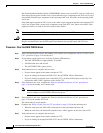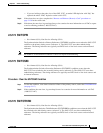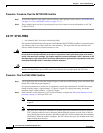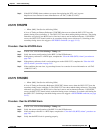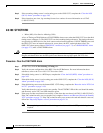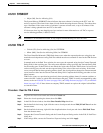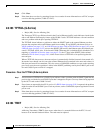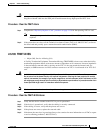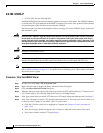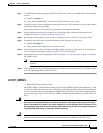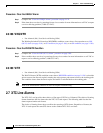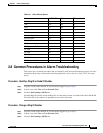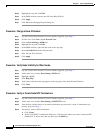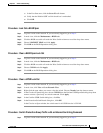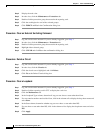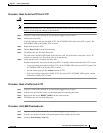
2-122
Cisco ONS 15327 Troubleshooting Guide, R3.4
March 2004
Chapter 2 Alarm Troubleshooting
Alarm Procedures
2.6.186 UNEQ-P
• Critical (CR), Service Affecting (SA)
An SLMF UNEQ Path alarm occurs when the path does not have a valid sender. The UNEQ-P indicator
is carried in the C2 signal path byte in the SONET overhead. The source of the problem is the node that
is transmitting the signal into the node reporting the UNEQ-P.
The alarm might result from an incomplete circuit or an empty VT tunnel. UNEQ-P occurs in the node
that terminates a path.
Warning
Invisible laser radiation might be emitted from the end of the unterminated fiber cable or connector.
Do not stare into the beam directly with optical instruments. Viewing the laser output with certain
optical instruments (for example, eye loupes, magnifiers, and microscopes) within a distance of 100
mm might pose an eye hazard. Use of controls or adjustments or performance of procedures other than
those specified might result in hazardous radiation exposure.
Caution Deleting a circuit affects traffic.
Caution Always use the supplied electrostatic discharge wristband when working with a powered ONS 15327.
Plug the wristband cable into the ESD jack located between the top high-speed and XTC slots.
Note If you have created a new circuit but it has no signal, an UNEQ-P alarm is reported on the OC-N cards
and an AIS-P condition (see page 2-17) is reported on the terminating cards. These alarms clear when
the circuit carries a signal.
Procedure: Clear the UNEQ-P Alarm
Step 1 In node view, click View > Go to Network View.
Step 2 Right-click the alarm to display the Select Affected Circuits dialog box.
Step 3 Click the Select Affected Circuits dialog box.
Step 4 When the affected circuits appear, look in the Type column for VTT, which indicates a VT tunnel circuit.
A VT tunnel with no VTs assigned might be the cause of an UNEQ-P alarm.
Step 5 If the Type column does not contain VTT there are no VT tunnels connected with the alarm. Go to Step 7.
Step 6 If the Type column does contain VTT, attempt to delete these row(s). The node view does not allow you
to delete a valid VT tunnel or one with a valid VT circuit inside:
a. Click the VT tunnel circuit row to highlight it. Complete the “Delete a Circuit” procedure on
page 2-128.
b. If an error message dialog box appears, the VT tunnel is valid and not the cause of the alarm.
c. If any other columns contain VTT, repeat Step 6.



